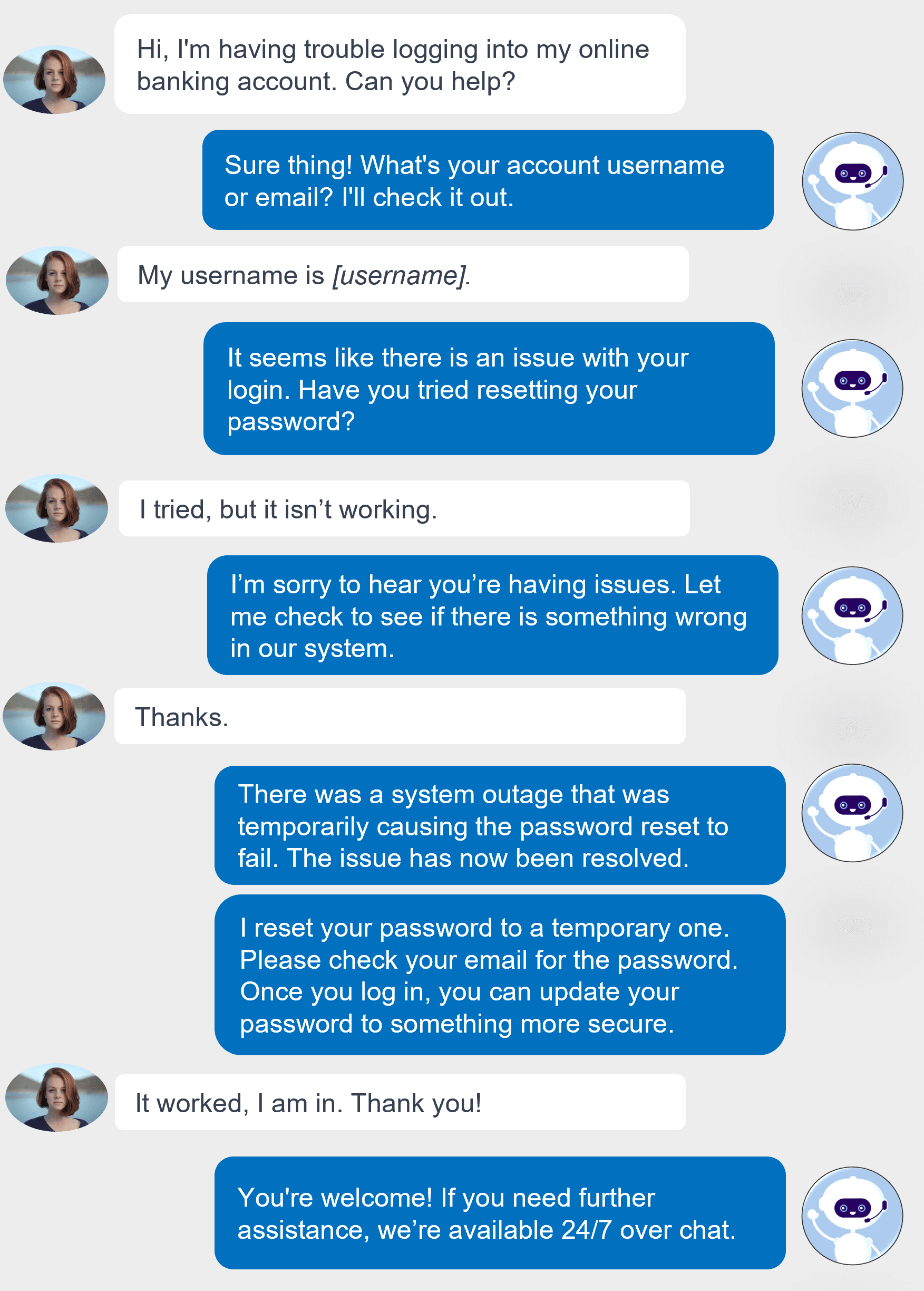It isn’t easy to imagine a sector of the economy that has not been impacted by artificial intelligence (AI). Natural language processing (NLP) and machine learning (ML) developments have enabled AI use across various industries and for multiple applications. One area where AI is becoming prevalent is in service delivery, specifically contact centers. This occurs via two distinct forms of AI: conversational and generative.
What is conversational AI?
Conversational AI is a form of artificial intelligence that enables humans to interact with a robot mimicking human forms of communication, such as words and text. Based on the words and their tone, the AI robot makes a real-time calculation for how to respond. The intent is to mirror what a human would say or write in the same scenario. In addition to words and voices, the robot considers several interaction elements, including dialect, slang, sarcasm, accents, and emojis.
The appeal of conversational Al is its ability to process information instantly and deliver immediate responses to queries. The ability to process information quickly enables conversational AI to replace the need to leverage a human for several types of interactions.
Why does conversational AI work well in a contact center?
Conversational AI has significant potential in contact centers, the conversational hub for most companies. Aside from the web, the contact center often handles the most interactions for any company and provides a substantial opportunity to redefine which interactions are handled by whom. Ideally, more routine transactions are handled by a robot, leaving complex topics for humans.
Traditionally, customers interact with frontline employees over the phone, email, or chat via the contact center. With the advancement of AI, businesses are experimenting with using virtual assistants and intelligent chatbots to handle customer queries and troubleshooting.
AI-powered systems and assistants use NLP and ML algorithms to comprehend and react to customer inquiries in real-time. They can provide standardized responses that are accurate, personalized and available 24/7.
Benefits of leveraging conversational & generative AI in your contact center
- • AI can enable employees by increasing their efficiency and productivity.
- • It can optimize and expand self-serve capabilities via IVR and chat, improving customer choice and experience.
- • It is capable of delivering differentiated experiences by leveraging institutional and customer data.
- • When integrated with automation, AI can eliminate mundane tasks and reduce operational costs.
How conversational AI creates savings and helps improve the automated customer experience
Calls are less expensive when routine transactional calls are offloaded to virtual assistants using conversational AI. The result is increased operational efficiency with options to reduce headcount or redirect savings towards selling by increasing the available time to speak with customers.
Implementing a conversational AI virtual assistant in an interactive voice response (IVR) can bring several benefits, including a more natural and intuitive experience. Conversational AI enables customers to interact with the IVR using spoken language as an alternative to selecting buttons on their phones.
Virtual assistants are also more mature and capable than traditional IVR speech recognition; they better understand customer requests and provide more precise instructions. Numerous contact centers and IVR vendors are adapting virtual assistants to make it accessible and affordable.
Using conversational AI to assist and improve real-time customer interactions

Conversational AI canhelp live interactions improve in real time. Conversational AI can depict how a customer feels during a conversation and notify employees who can quickly adjust their conversational approach.
Conversational AI can detect patterns and tendencies in customer interactions. Using these patterns, frontline employees can receive real-time coaching and training, improving customer interactions. For example, Cogito Dialogue assists frontline employees in having more empathetic and productive conversations, resulting in improved contact center efficiency and customer experience. It leverages ML algorithms and NLP to analyze real-time customer interactions. It provides frontline employees with guidance and feedback based on behavioural cues such as language, speed, and tone of voice. Cogito Dialogue can help frontline employees understand when customers are becoming emotional or agitated during an interaction and provide support for creating calm while being empathetic. The tool also assists contact center managers with analytics into customer satisfaction, frontline employee performance, and overall efficiency that can improve internal operations.
Conversational AI positively impacts several different metrics used to assess contact center performance, such as:
- Frontline employee attrition
- Average handle time (AHT)
- First call resolution (FCR)
- Customer satisfaction (CSAT)
What is generative AI?
Generative Al refers to machine learning algorithms that enable computers to use existing content like text, audio, video, images, and code to create new content. It generates completely original content using patterns from existing datasets on which the model was trained. Generative AI uses large language models and advanced algorithms to identify data patterns and generate new data for various applications. These models can advance customer service within contact centers by providing personalized, tailored responses to customer queries using abundant institutional knowledge.
Using generative AI for chat solutions
Contact centers have continuously evolved to become a highly dynamic environment requiring frontline employees to manage an ever-increasing volume of customer interactions. While traditional communication channels such as voice and email remain important, the emergence of messaging tools has opened new avenues for customer engagement.
In recent years, a combination of automated chatbots and live chat has resolved customer queries through chat solutions. While chat is sometimes helpful, issues have surfaced, such as needing more personalization from standardized responses or unmet speed expectations with response times. Generative AI resolves these issues because it can help tailor customized responses and elevate customer conversations. Generative AI-powered chat solutions use advanced natural language processing and large language models to answer complex customer enquiries and engage quickly and meaningfully. Continuing advancement in generative AI will transform how customers interact via chat. As a result, deploying this channel will become cheaper, faster, and more effective while substantially improving the customer’s experience.
Ada, a leading AI-powered customer service automation platform, has enhanced its offering to use generative AI. Chatbots using Ada can build responses from existing knowledge bases, including previous customer interactions. Additionally, Ada can train chatbots to recognize customer intent. The chatbot can leverage large language models to dynamically generate automated responses using customer data and past interactions. The result is a more personalized experience for the customer. Generative AI will power customer service solutions to enhance contextual understanding and automate complex interactions, solving the challenges with traditional chatbot solutions.
Response through conversational AI

Conversational AI suggests connecting the user with a frontline employee when the user expresses frustration, indicating its limitations in understanding and addressing complex emotions.
Response through generative AI

Generative AI acknowledges the user’s emotions, interprets their frustration, and tries to resolve the issue without escalating to a frontline employee, showcasing its greater capacity to understand and navigate emotional nuances.
Using generative AI to optimize knowledge management
Contact centers often need help with difficulties that impact their efficiency and hinder frontline employees from providing the best possible customer service. Gaps in knowledge, processes, systems, and unclear resource information make it more difficult for frontline employees to address and resolve customer inquiries. Managers sometimes need help to provide frontline employees with the knowledge and support they need.
Knowledge management tools are the foundation for frontline employees to acquire information. These helpful and intuitive tools are necessary for frontline employees who sometimes feel they must fend for themselves. Considering how much information frontline employees must retain, problem-solving becomes more difficult. Data can be dispersed across various systems, making it challenging for employees to find what they require to help customers. Furthermore, depending on the source, the information may need to be more consistent and clearer. Combined, this leads to uncertainty and makes it harder for employees to speak intelligently and accurately when they work to resolve inquiries.
Generative AI is a game changer for quickly and easily accessing information. The AI model can learn from past customer interactions to predict appropriate responses to frequent queries. Furthermore, generative AI constantly learns from conversations, enabling it to gain knowledge over time. As a result, frontline employees acquire accurate information faster, allowing them to resolve customer inquiries quickly. Improved access to information translates to an improved employee and customer experience while creating savings and building brand loyalty.
Level AI’s solution, Agent GPT, is an excellent example of generative AI via knowledge management in action. Agent GPT is trained on organizational data to generate responses related to its business. It learns from institutional knowledge over the years and continuously improves based on live interactions. Using NLP, Agent GPT understands the reason for a customer’s inquiry and provides employees with solution options derived from a combination of past customer interactions and the organization’s knowledge base. Agent GPT assists employees and eliminates the need to search through long knowledge articles or reach out to supervisors for help. The outcome is transformative regarding time saved and successful outcomes reached, including improved AHT and FCR.
It is important to remember that while generative AI is a powerful tool for knowledge management in contact centers, it cannot replace humans. While the AI model can respond to typical questions with speed and accuracy, there will be situations that will always demand human empathy, intuition and problem-solving, especially more complex queries. Therefore, a successful application of generative AI in contact centers should concentrate on increasing efficiency rather than replacing humans.
The future of conversational and generative AI
Conversational AI and generative AI are compelling technologies that will reshape the landscape of service delivery within organizations. In the future, the two technologies have the potential to work simultaneously and create more advanced and holistic solutions. A convergence would result in more engaging and dynamic conversations that feel more human-like and adaptable to various scenarios, thereby improving customer engagement. Combining the capabilities would also lead to systems that better understand the nuances of user queries, resulting in more accurate, personalized and relevant responses that adapt to the conversation flow. As these technologies evolve, we will see more organizations implement customer-centric enterprise solutions to improve the overall efficiency of its operations.
By: Nehal Bajpai, Eli Federman & Ankit Vig
About the authors
Read more insights on contact centers
Find out how we can help you improve your contact center.
CONTACT US






